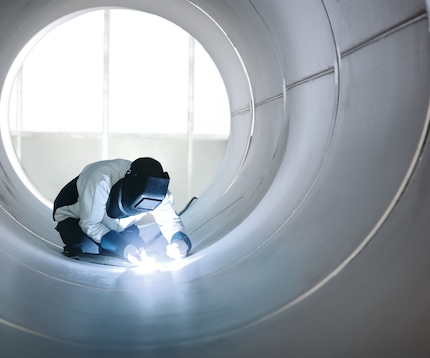
Linde's latest welding wonder, the ARCLINE® PAW is more than just a redesign of a plasma arc welding system; it might just be the revival of a dying art.
The forces of nature can severely afflict human-built structures. Here is how the LINDOFLAMM® program ensures that eco power plants withstand wind and water.

Renewable energy sources are most effective when they are at their most fierce: Wind turbines are most productive offshore where winds speeds are high and consistent. Hydropower depends on the forces of massive bodies of water in motion.
But that means the technology that captures and processes this energy needs to be extremely sturdy. The monopile of an offshore wind turbine has to take the constant pounding of waves and push of storm winds. In a downpipe of a hydropower plant, huge masses of water hammer down. Under harsh conditions, anything that compromises the integrity of such a construction can translate into catastrophic failure. This is where Linde’s LINDOFLAMM® solutions come into play.
As pipes, support structures or tower components, high strength steel segments make up a large part of these constructions. Consequently, welding processes become particularly important. Steel plates for wind turbine towers can be as massive as 30 m long, 4 m wide and 12 cm thick. “Welding these can be a challenge,” explains Florian Lang, technology expert for thermal processes at Linde. “Particularly, you want to avoid weak weld seams that break under internal stresses or shearing forces. Hydrogen-induced cracking, or Cold Cracking, as we call it, is another typical threat. It happens when H2 diffuses into the metal during welding.”

The solution: Pre- and post-heating. These are crucial, albeit time-consuming steps. Pre-heating involves heating the area around the weld joint to a specific temperature. It counters residual and load stresses. In addition, it removes moisture from the heat-affected zone. Post-heating counteracts stresses as well, by reducing the cooling rate of the weld.
While there are many ways of pre- and post-heating and several gases that can do the job, Linde’s acetylene-based burner technology LINDOFLAMM® brings distinctive advantages: “Acetylene has a high heat intensity in the primary flame. It allows for a high efficiency that benefits a fast production speed,” explains Florian Lang. “Its focused and stable flame pre-heats only the weld area of the workpiece. At the same time, it increases the heating speed, compared to all other fuel gases.”
So, when time and precise heating are of the essence, acetylene’s characteristics support increased productivity and significant savings on total process cost. “Plus, acetylene has the lowest moisture content in exhausted gases. The risk of hydrogen enclosures and subsequent embrittlement is significantly lower, thus decreasing the risk of Cold Cracking,” says Florian Lang.

Tailor-made systems are often a necessity when standard or automated systems are not yet available. Also specific configurations, such as project size or conditions at the building site, can call for custom solutions. Then, it’s not just a case of requiring a versatile product - but also an innovative and supportive partner like Linde. LINDOFLAMM® is an extensive process-supply-service offer that comprises high-quality fuel gases, burner technology, and dedicated systems, with manual as well as mechanization and automatization options.
For example, in one case, a provider was called in on a temporary construction site of a hydropower plant, to provide on-site manufacturing of custom steel pipes. “Time for preparation was short; production was to begin in a short time. So the provider asked us for an effective on-site pre-heating solution”, says Florian Lang.
Linde had little time for preliminary testing, but was able to draw from past experiences. “We came up with an individual solution that included several standard as well as tailor-made burners and installed a LINDOMATIK® pressure-regulating station for acetylene supply,” explains Florian Lang.

The scope of LINDOFLAMM® provides everything from standard task to fully tailor-made solutions, delivered with Linde’s expertise and range of support offers, from design to implementation, with quality and safety services such as audits and trainings.
Apropos safety: The LINDOFLAMM® burner portfolio was subjected to a comprehensive “type testing”. This method is a rigorous conformity assessment across an extensive number of variables - approached from mathematical, physical, chemical, and logical perspectives.
As such, it goes well beyond simple regulatory compliance to meet the highest levels of modern-day conformance requirements in terms of specifications, technical standards, regulations, and contracts. Linde is the only burner manufacturer to guarantee their technology to such a high standard.

"It was a huge effort to test our whole burner program against every corresponding norm and standard, for example regarding wind stability, gas tightness or resistance to overheating,” explains Florian Lang.
In addition, Linde’s customers themselves have to meet accountability requirements. And automation and the Internet of Things (IoT) put a new and intensified focus on safety aspects. So, as Florian Lang says: “It goes without saying that we demand the best performance of our product, for the sake of quality, usability, and also safety.”
Meanwhile, the ultimate quality control takes place in the field - or the ocean for that matter. Hydropower plants are often laid out for 50 to 100 years of operating, and even offshore wind turbines have to stand the rough sea for 20 to 25 years. With LINDOFLAMM®, these renewable energy power plants really can stand the test of tide and time.

Linde's latest welding wonder, the ARCLINE® PAW is more than just a redesign of a plasma arc welding system; it might just be the revival of a dying art.

Linde's gases, application technologies and expertise in metal fabrication can help increase efficiency and profitability in welding, cutting, heating, joining, AM, surface treatment & more